Just as a single palm tree can transform a barren coastline into paradise, big-leaf plants can revolutionize your indoor space. You’ll discover how these stunning tropical specimens, ranging from 3 to 15 feet tall, create instant impact with their dramatic foliage and architectural presence. Whether you’re working with a sunny living room or a humid bathroom, there’s a statement-making tropical plant that’ll turn your home into an exotic retreat – and the options might surprise you.
Contents
- 1 1. Bird of Paradise Plant
- 2 2. Monstera Deliciosa
- 3 3. Elephant Ear Philodendron
- 4 4. Majesty Palm
- 5 5. Rubber Plant (Ficus Elastica)
- 6 6. Chinese Fan Palm
- 7 7. Giant Taro Plant
- 8 8. Giant Snake Plant
- 9 9. White Bird of Paradise
- 10 10. Giant Heart Leaf Philodendron
- 11 11. Giant Tropical Umbrella Plant
- 12 12. Calathea Orbifolia
- 13 13. Elephant Ear
- 14 14. Dumb Cane
- 15 15. Banana Plant
1. Bird of Paradise Plant
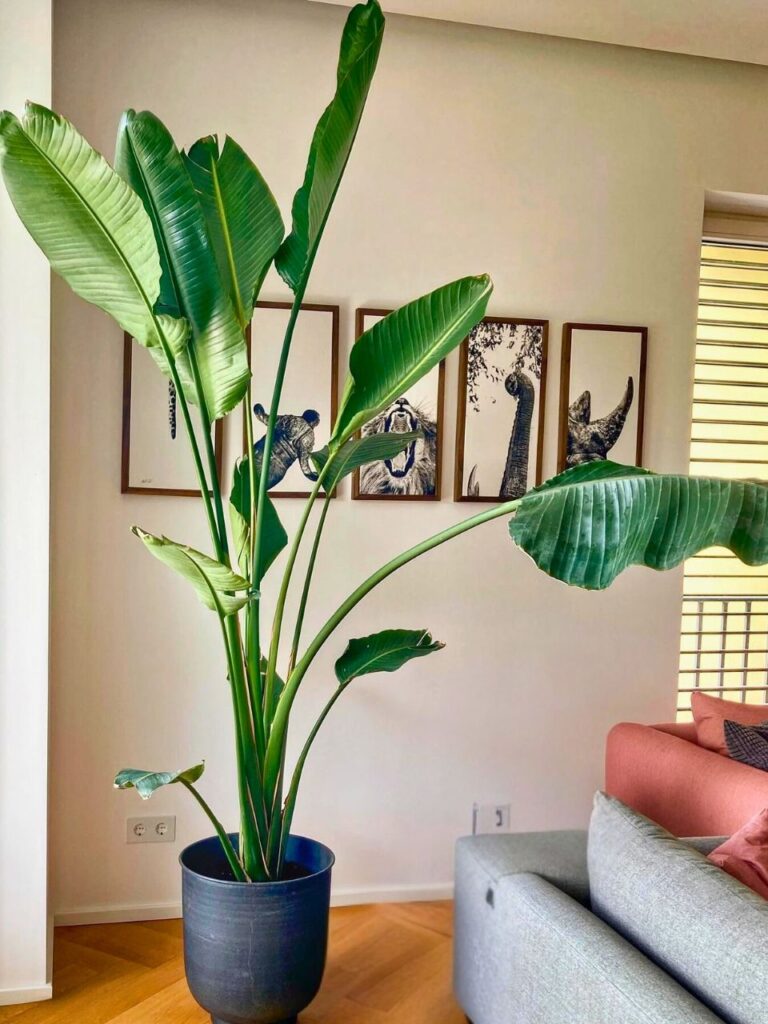
The Bird of Paradise (Strelitzia reginae) is a striking tropical plant known for its large, paddle-shaped leaves and unique crane-like flowers that resemble exotic birds in flight. Native to South Africa, this evergreen perennial can grow 4-6 feet tall indoors and up to 30 feet outdoors in suitable climates. The plant produces distinctive blooms in orange and blue colors, making it a dramatic focal point in any space, while its broad, banana-like foliage adds a bold tropical statement to gardens and indoor settings.
- Light: Bright, indirect sunlight; can tolerate direct morning sun but needs protection from harsh afternoon rays
- Water: Keep soil consistently moist but not waterlogged; reduce watering in winter
- Soil: Well-draining, rich potting mix with organic matter
- Temperature: 65-80°F (18-27°C); cannot tolerate freezing temperatures
- Humidity: High humidity (50% or higher); benefits from regular misting
- Fertilizer: Feed every 2-3 months during growing season with balanced fertilizer
- pH: 6.0-7.5
- Space: Needs room to spread; plant 4-6 feet apart outdoors
2. Monstera Deliciosa

Monstera deliciosa, commonly known as the Swiss cheese plant or split-leaf philodendron, is a striking tropical vine native to Central American rainforests. This popular houseplant features large, glossy, heart-shaped leaves that develop distinctive perforations and deep splits as they mature, creating its iconic fenestrated appearance. The plant can grow quite large indoors, reaching heights of 10-15 feet when properly supported, and in its natural habitat can produce edible fruit that tastes like a blend of pineapple and banana.
- Light: Bright, indirect light; can tolerate moderate shade but avoid direct sunlight which can burn leaves
- Water: Keep soil consistently moist but not waterlogged; water when top 1-2 inches of soil feels dry
- Soil: Well-draining, rich potting mix with high organic matter content
- Humidity: Prefers high humidity levels (60-80%); benefits from regular misting
- Temperature: 65-85°F (18-29°C); protect from cold drafts
- Support: Requires moss pole or trellis for climbing as it matures
- Fertilizer: Monthly feeding during growing season with balanced houseplant fertilizer
3. Elephant Ear Philodendron
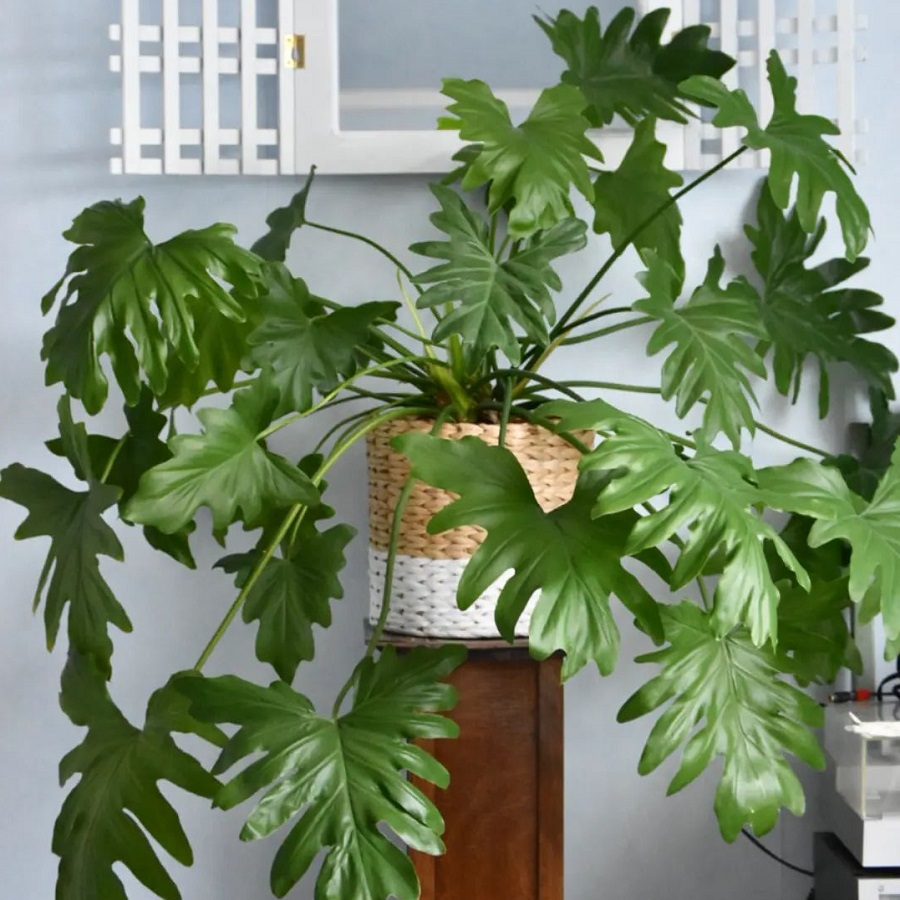
The Elephant Ear Philodendron (Philodendron bipinnatifidum) is a striking tropical plant known for its massive, deeply-lobed leaves that can grow up to 3 feet long. This architectural plant makes a bold statement in any space, growing up to 15 feet tall and wide in ideal conditions. Native to South America, it starts as a compact plant but develops a trunk-like stem as it matures, creating a tree-like appearance that adds dramatic vertical interest to indoor and outdoor spaces.
- Light: Bright, indirect light; can tolerate some direct morning sun but protect from harsh afternoon rays
- Water: Keep soil consistently moist but not waterlogged; water when top 1-2 inches of soil feels dry
- Soil: Well-draining, rich organic potting mix
- Humidity: High humidity levels (50-60% or higher)
- Temperature: 65-80°F (18-27°C); protect from temperatures below 55°F (13°C)
- Fertilizer: Feed monthly during growing season with balanced liquid fertilizer
- Support: May need staking or support as it grows larger
- Container: Large pot with drainage holes to accommodate extensive root system
4. Majesty Palm
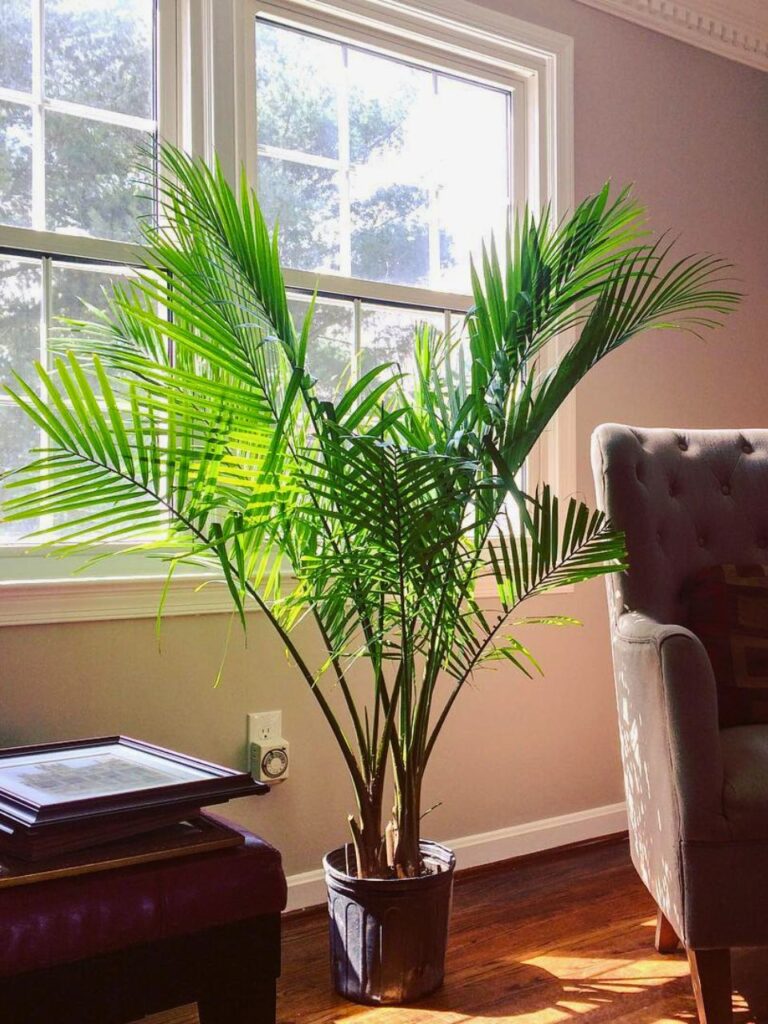
The Majesty Palm (Ravenea rivularis) is a graceful, feather-frond palm that brings an elegant tropical ambiance to indoor and outdoor spaces. Native to Madagascar, this slow-growing palm can reach heights of 10 feet indoors and up to 80 feet in its natural habitat. Its long, arching fronds create a classic palm silhouette, featuring multiple leaflets arranged along each stem. While often grown as a houseplant, the Majesty Palm can also thrive outdoors in warm climates and makes an excellent container specimen for patios and poolside areas.
- Light: Bright, indirect light; can tolerate some direct morning sun; avoid harsh afternoon sun
- Water: Keep soil consistently moist but not waterlogged; water when top inch of soil feels dry
- Soil: Well-draining, rich potting mix with added peat moss
- Humidity: High humidity (50% or higher); benefits from regular misting
- Temperature: 65-80°F (18-27°C); protect from cold drafts
- Fertilizer: Feed with balanced fertilizer every 2-3 months during growing season
- pH: 5.0-6.5
- Growth Zone: USDA zones 9-11 for outdoor growing
5. Rubber Plant (Ficus Elastica)
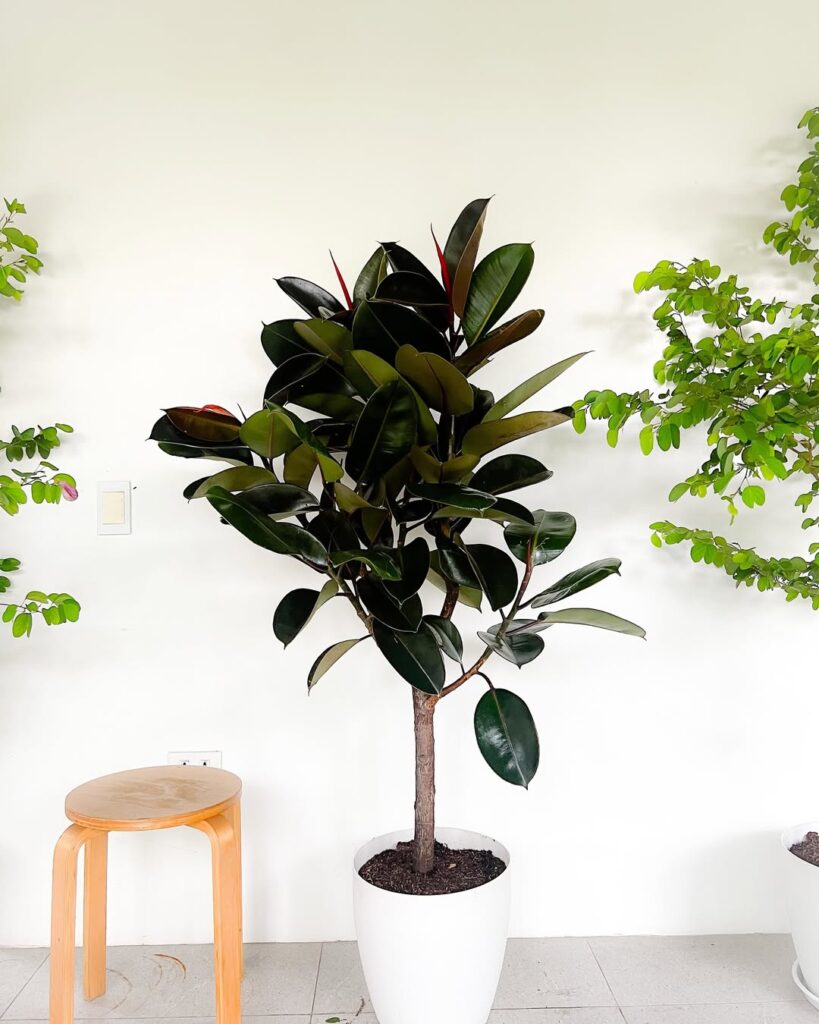
The Rubber Plant (Ficus elastica) is a striking indoor plant known for its large, glossy leaves that can grow up to 12 inches long. Native to Southeast Asia, this popular houseplant can reach heights of 6-10 feet when grown indoors, though it can grow much taller in its natural habitat. Its thick, leathery leaves are typically dark green with a reddish midrib, though variegated varieties are also available. The plant earned its common name from its white latex sap, which was once used in rubber production.
- Light: Bright, indirect light; can tolerate some direct morning sun but avoid harsh afternoon light; adapt well to medium light conditions
- Water: Allow top 1-2 inches of soil to dry between waterings; reduce watering in winter
- Soil: Well-draining, rich potting mix with good aeration
- Humidity: Moderate to high; benefits from regular misting or humidity tray
- Temperature: 60-75°F (15-24°C); avoid cold drafts
- Fertilizer: Feed monthly during growing season with balanced liquid fertilizer
- Soil pH: 5.5-7.0
- Container: Large pot with drainage holes; repot every 2-3 years
6. Chinese Fan Palm
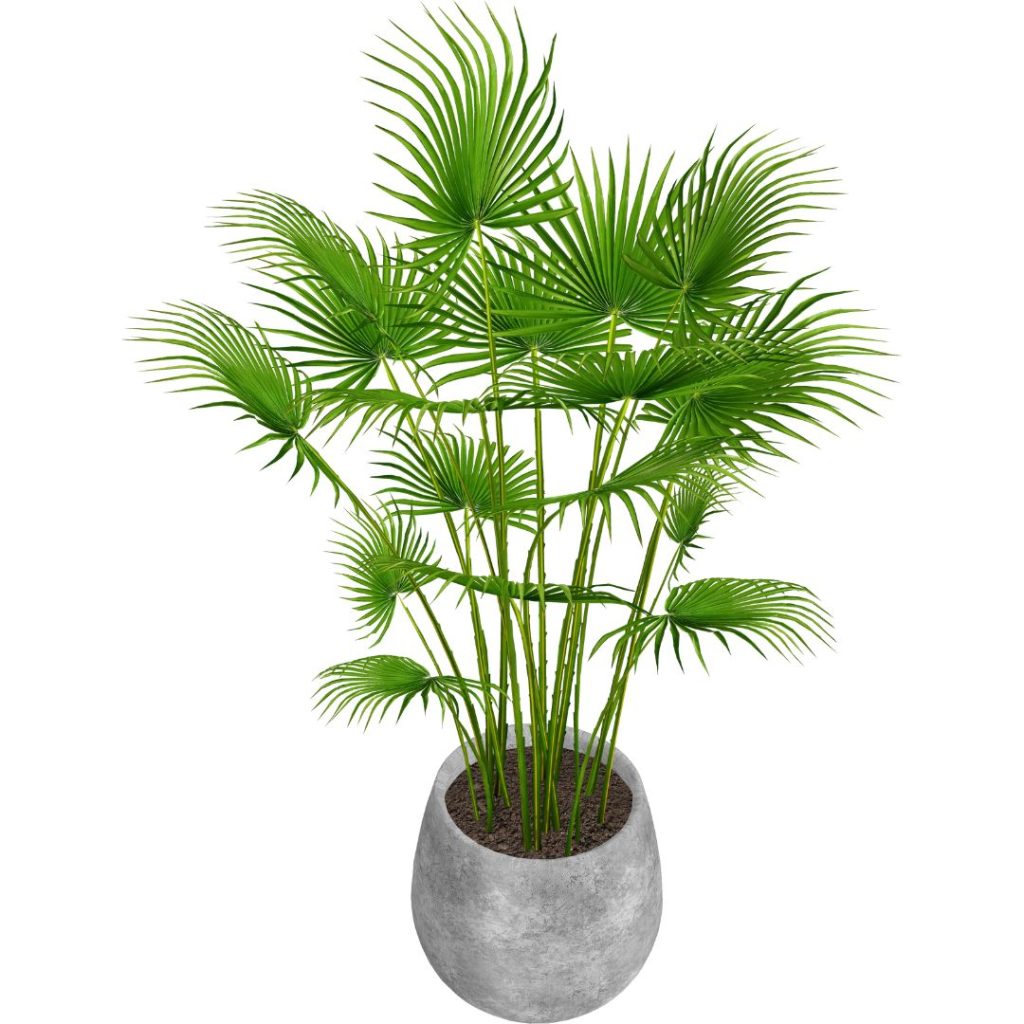
The Chinese Fan Palm (Livistona chinensis) is a stunning palm species known for its large, fan-shaped fronds that can span up to 6 feet wide. These glossy, dark green leaves are deeply segmented and grow in a circular pattern atop tall, sturdy trunks, creating an impressive tropical silhouette. While slow-growing, these palms can eventually reach heights of 30-50 feet in their natural habitat, though they typically remain smaller when grown as houseplants or in contained outdoor spaces.
- Light: Bright, indirect light; can tolerate partial shade; protect from intense afternoon sun
- Water: Keep soil consistently moist but not waterlogged; reduce watering in winter
- Soil: Well-draining, rich potting mix with good organic content
- Temperature: 65-80°F (18-27°C); not frost-tolerant
- Humidity: Moderate to high; benefits from regular misting
- Fertilizer: Feed with balanced palm fertilizer during growing season
- Zone: USDA 9-11 for outdoor growing
- Container: Large pot with adequate drainage holes
- pH: 6.1-6.5 (slightly acidic)
7. Giant Taro Plant
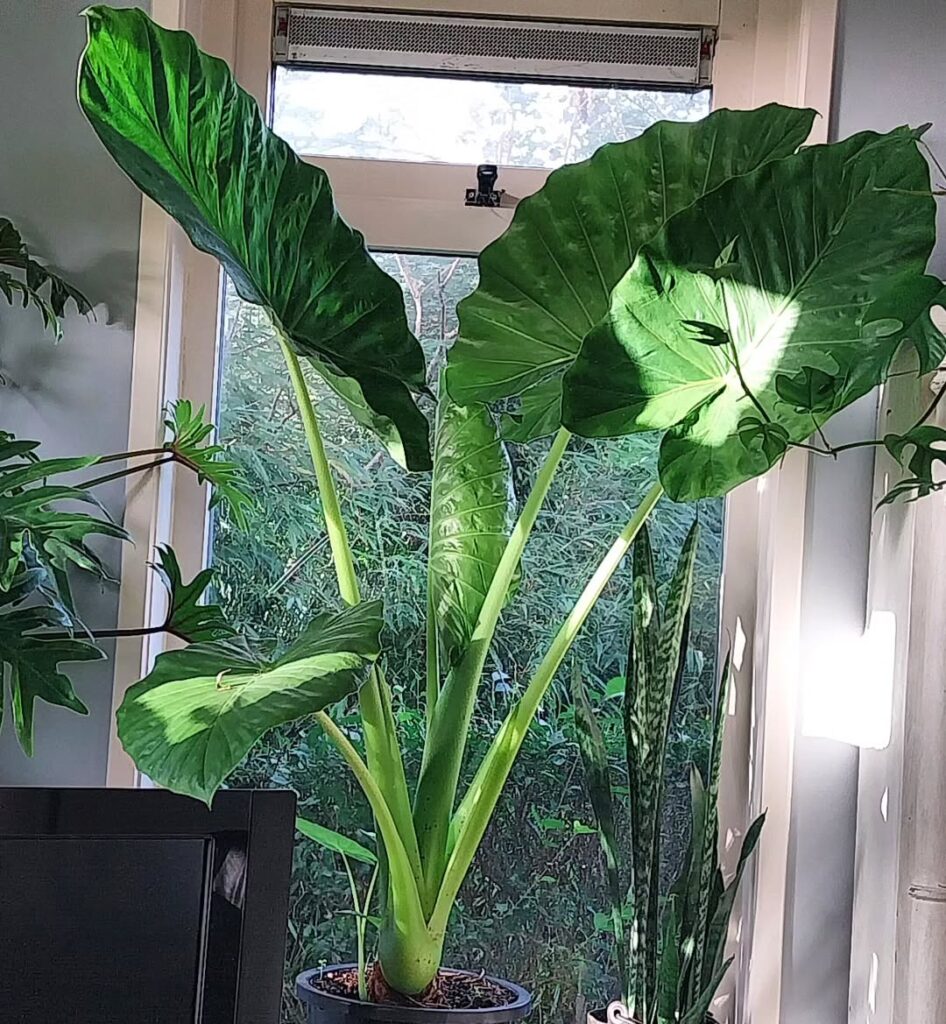
The Giant Taro (Alocasia macrorrhiza) is a striking tropical plant known for its massive, arrow-shaped leaves that can grow up to 6 feet long and 4 feet wide. This impressive specimen can reach heights of 12-15 feet in ideal conditions, making it a dramatic focal point in tropical gardens or large indoor spaces. Native to Southeast Asia and the Pacific Islands, the Giant Taro features thick, sturdy stems and glossy, dark green foliage with prominent veining that adds textural interest to any setting.
- Light: Bright, indirect sunlight; can tolerate partial shade but avoid direct sun which may burn leaves
- Water: Keep soil consistently moist but not waterlogged; reduce watering in winter
- Soil: Rich, well-draining potting mix with high organic content
- Humidity: High humidity levels (60% or higher)
- Temperature: 60-85°F (15-29°C); not frost tolerant
- Fertilizer: Regular feeding during growing season with balanced fertilizer
- Space: Needs ample room to spread; minimum 6 feet spacing between plants
- Zone: USDA zones 9-11 for outdoor growing
8. Giant Snake Plant
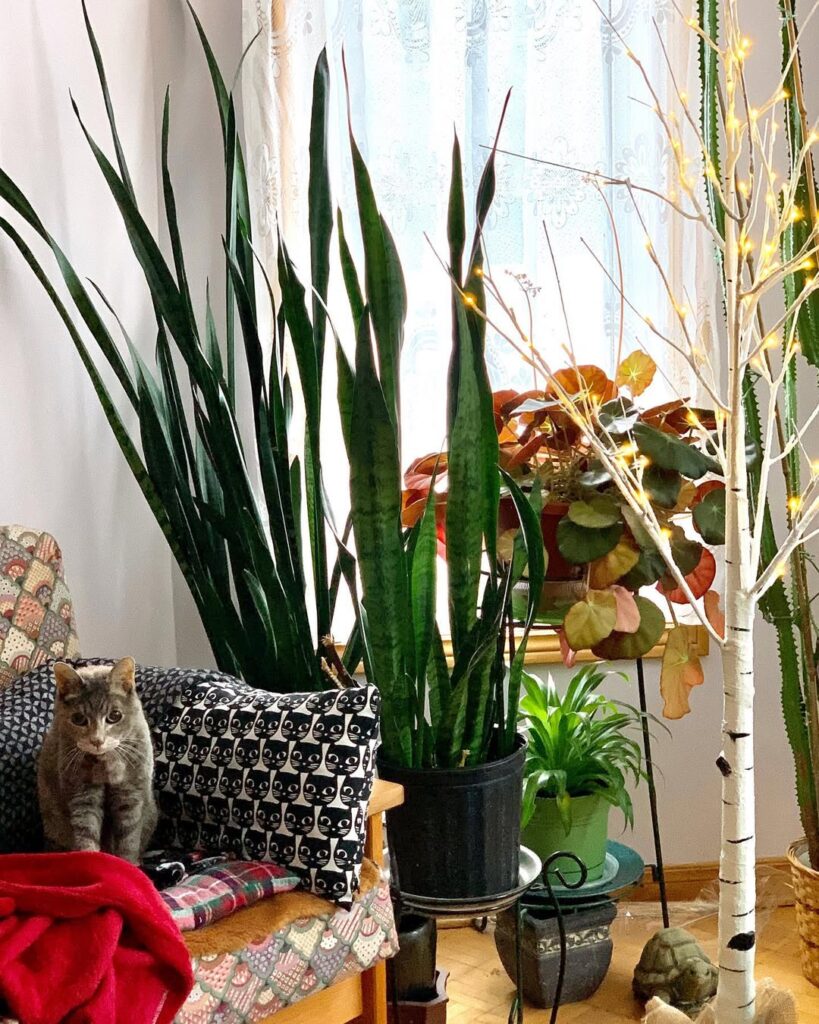
The Giant Snake Plant (Sansevieria trifasciata ‘Laurentii’) is a dramatic architectural plant that can grow up to 4-6 feet tall with thick, sword-shaped leaves featuring distinctive yellow edges and dark green centers. As a member of the Sansevieria family, this variety stands out for its impressive size and striking variegation, making it an excellent choice for creating a tropical atmosphere in both indoor and outdoor spaces. Its upright growth pattern and structural form make it particularly effective as a focal point or room divider.
- Light: Tolerates low light but thrives in bright, indirect sunlight; can handle some direct sun
- Water: Drought-tolerant; water only when soil is completely dry; less frequent watering in winter
- Soil: Well-draining potting mix; prefers slightly sandy soil
- Temperature: 60-85°F (15-29°C)
- Humidity: Adaptable to various humidity levels
- Fertilizer: Light feeding during growing season with balanced fertilizer
- Container: Deep pot with drainage holes to accommodate extensive root system
- Spacing: Plant 2-3 feet apart if growing multiple specimens
9. White Bird of Paradise
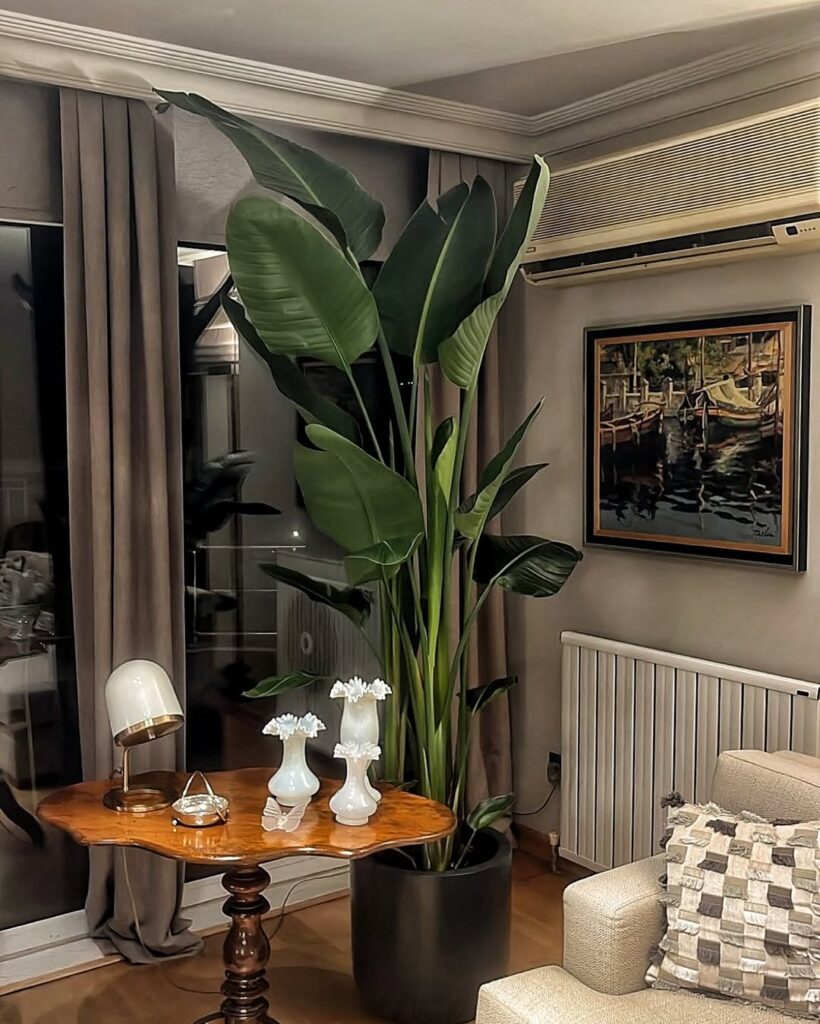
The White Bird of Paradise (Strelitzia nicolai) is a dramatic tropical plant known for its massive paddle-shaped leaves that can reach heights of 20-30 feet in ideal conditions. Native to South Africa, this architectural beauty features a fan-like arrangement of long-stalked leaves that can span up to 8 feet in length. While similar to its smaller cousin Strelitzia reginae, this species grows considerably larger and produces white and blue flowers rather than orange ones, though flowering is rare when grown indoors.
- Light: Bright, indirect light; can tolerate some direct sun but may scorch in intense afternoon light
- Water: Keep soil consistently moist but not waterlogged; water when top 2-3 inches of soil feels dry
- Soil: Rich, well-draining potting mix with high organic content
- Humidity: Prefers high humidity; benefits from regular misting or humidifier
- Temperature: 65-80°F (18-27°C); cannot tolerate frost
- Fertilizer: Feed monthly during growing season with balanced fertilizer
- Space: Needs ample room to spread; best in large containers or outdoor spaces
- Drainage: Requires excellent drainage to prevent root rot
10. Giant Heart Leaf Philodendron
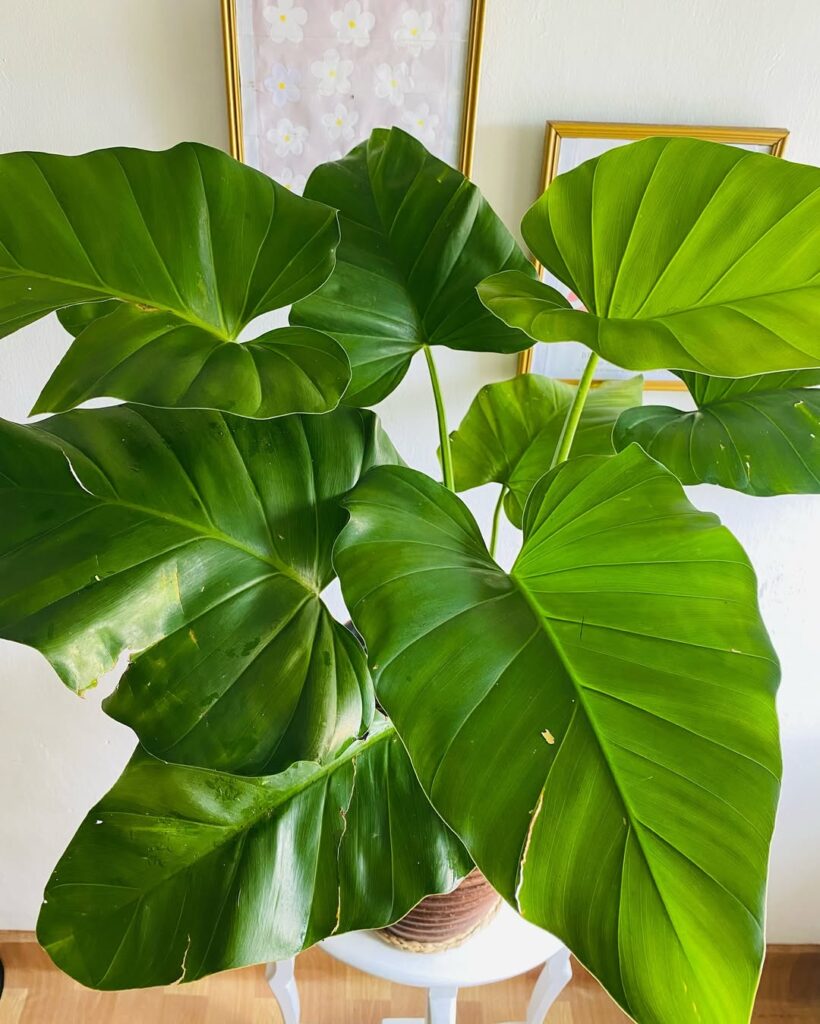
The Giant Heart Leaf Philodendron (Philodendron giganteum) is a striking tropical plant known for its massive, glossy heart-shaped leaves that can grow up to 3 feet long. This climbing variety develops thick stems and aerial roots as it matures, making it an impressive specimen for indoor spaces. While smaller when young, this philodendron can reach heights of 15 feet or more in ideal conditions, creating a dramatic tropical focal point.
- Light: Bright indirect light; can tolerate medium light but avoid direct sun
- Water: Keep soil consistently moist but not waterlogged; water when top 1-2 inches of soil feels dry
- Soil: Well-draining, rich potting mix with added peat moss and perlite
- Humidity: Prefers high humidity levels of 60% or more
- Temperature: 65-80°F (18-27°C); protect from cold drafts
- Fertilizer: Feed monthly during growing season with balanced liquid fertilizer
- Support: Provide moss pole or trellis for climbing as plant matures
11. Giant Tropical Umbrella Plant
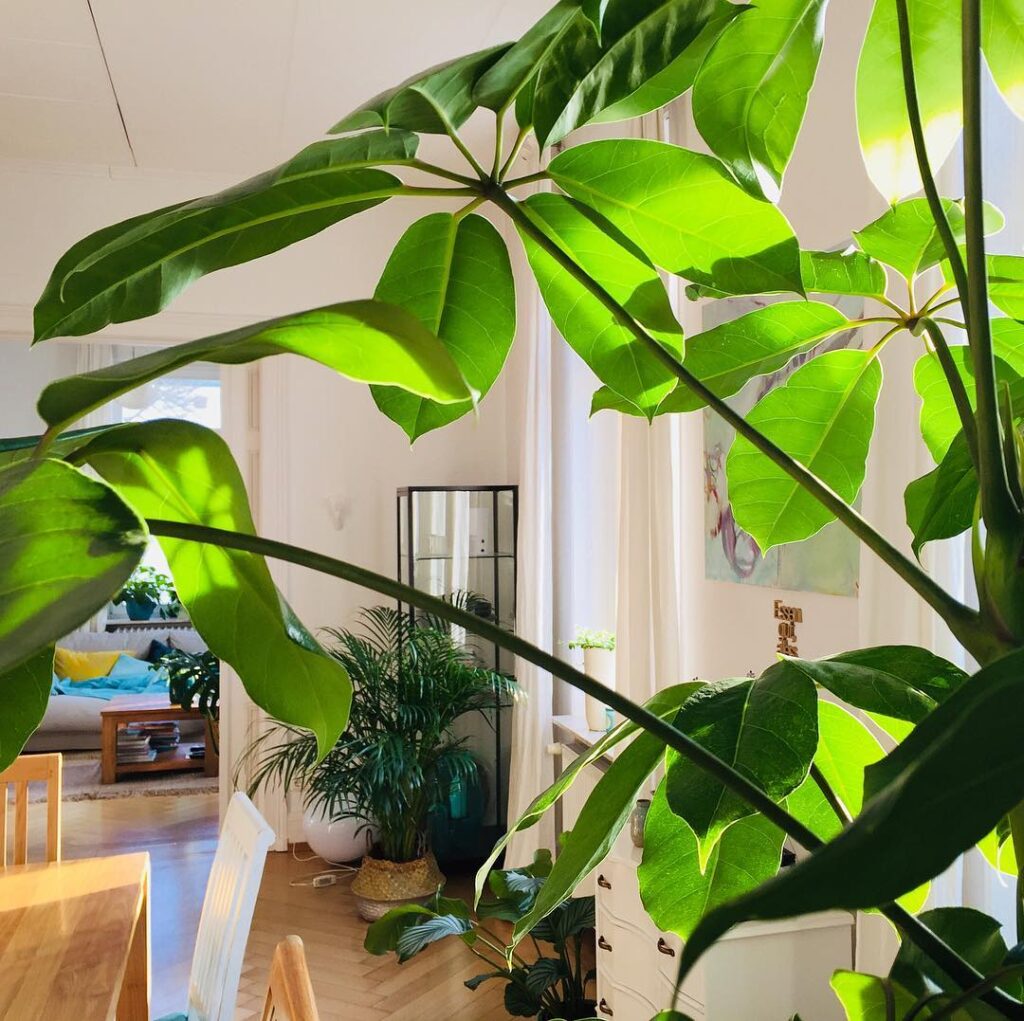
The Giant Tropical Umbrella Plant (Schefflera actinophylla) is a striking tropical specimen that can reach heights of 40 feet or more in its natural habitat, though it typically stays smaller as a houseplant. Known for its distinctive umbrella-like leaf formations, each leaf consists of leaflets radiating outward from a central point, creating a dramatic architectural effect. The plant produces long, finger-like red flower spikes that emerge from the top of the plant when grown outdoors, adding to its exotic appeal.
- Light: Bright, indirect light; can tolerate partial shade but needs good light for best growth
- Water: Keep soil consistently moist but not waterlogged; reduce watering in winter
- Soil: Well-draining, rich potting mix with organic matter
- Humidity: Prefers high humidity levels of 60% or more
- Temperature: 60-85°F (15-29°C); cannot tolerate frost
- Fertilizer: Feed monthly during growing season with balanced liquid fertilizer
- pH: 6.0-6.5
12. Calathea Orbifolia

The Calathea orbifolia is a stunning foliage plant known for its large, round leaves adorned with silver-green stripes. Native to South America, this plant thrives in indoor environments where humidity is maintained. Its broad leaves not only add elegance to a space but also help in improving air quality.
- Light: Bright, indirect light; avoid direct sun to prevent leaf scorch
- Water: Keep soil consistently moist but not soggy; use filtered water if possible
- Soil: Well-draining, peat-based mix with organic matter
- Humidity: High humidity (60% or more); regular misting or a humidity tray helps
- Temperature: 65-80°F (18-27°C); sensitive to sudden temperature changes
- Fertilizer: Feed monthly with diluted liquid fertilizer during growing season
- pH: 5.5-6.5
13. Elephant Ear
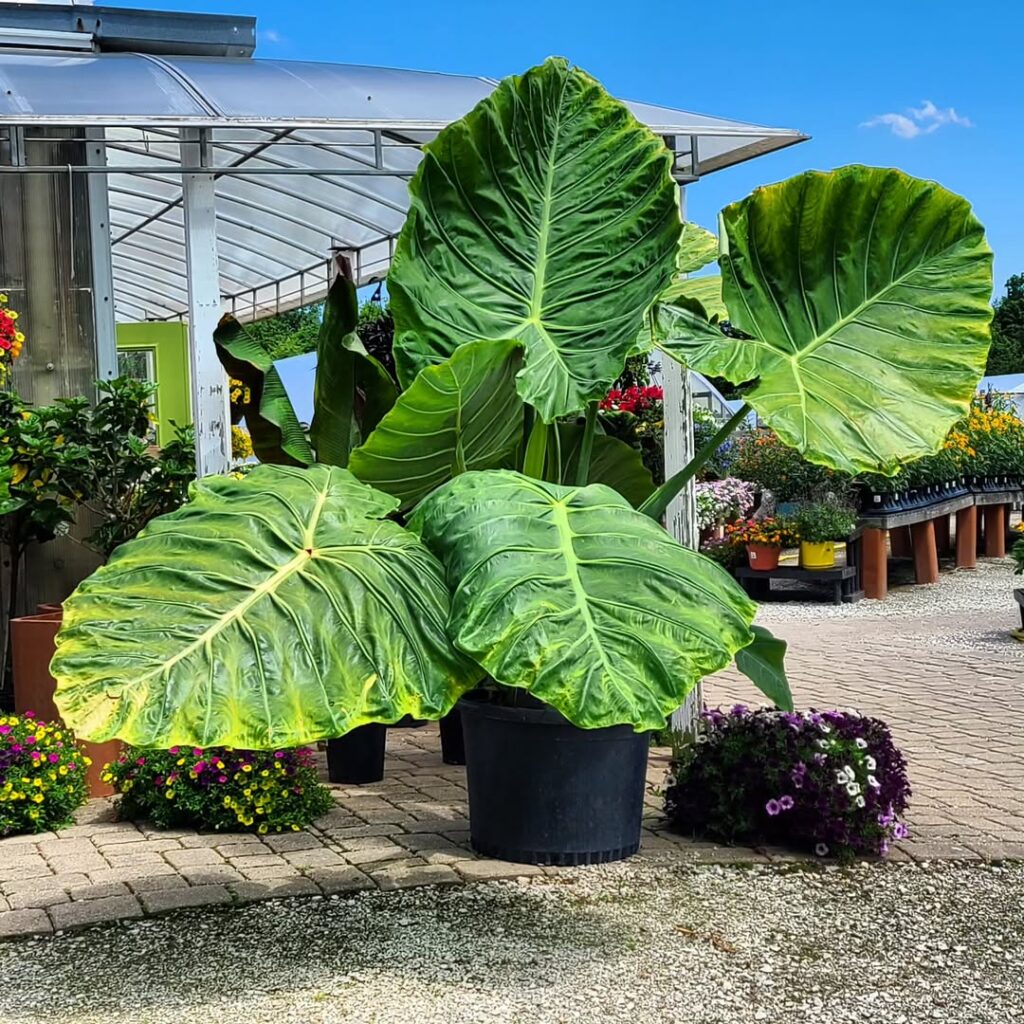
The Elephant Ear (Colocasia) plant is a dramatic, tropical favorite with oversized, heart-shaped leaves that bring an exotic touch to interiors. These plants, native to warm climates, thrive in moist environments and can grow impressively large, making them ideal for bold indoor greenery.
- Light: Bright, indirect light; tolerates partial shade
- Water: Keep soil consistently moist; do not allow to dry out completely
- Soil: Rich, well-draining potting mix with organic material
- Humidity: Prefers humidity levels above 60%; misting recommended in dry environments
- Temperature: 65-85°F (18-29°C); not frost-tolerant
- Fertilizer: Feed biweekly with balanced fertilizer during growing season
- pH: 6.0-6.8
14. Dumb Cane
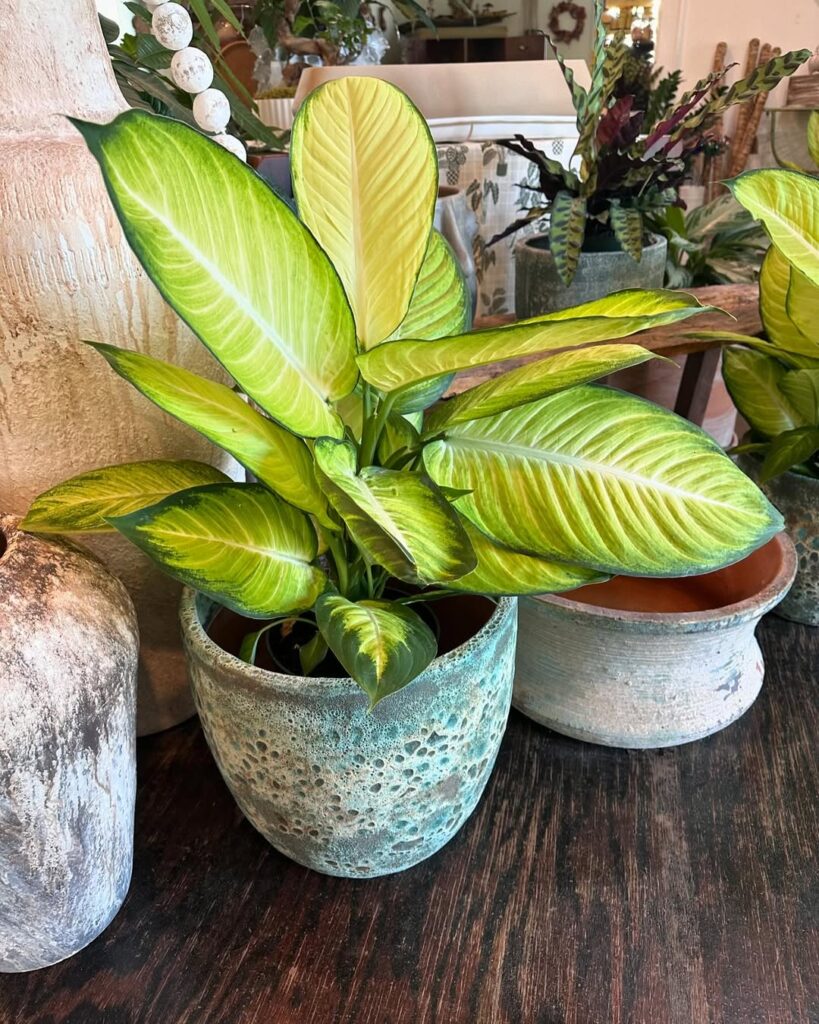
Dumb Cane (Dieffenbachia) is a lush indoor plant with large, variegated leaves that display unique creamy patterns. Known for its ability to brighten indoor spaces, this plant is easy to care for and can grow into an impressive focal point in any home.
- Light: Bright, indirect light; tolerates low light but grows best with more exposure
- Water: Water moderately, keeping soil evenly moist but avoiding overwatering
- Soil: Well-draining, nutrient-rich potting mix
- Humidity: Prefers 50-60% humidity; occasional misting keeps foliage healthy
- Temperature: 65-75°F (18-24°C); protect from cold drafts
- Fertilizer: Feed monthly with a balanced liquid fertilizer during spring and summer
- pH: 6.0-7.0
15. Banana Plant
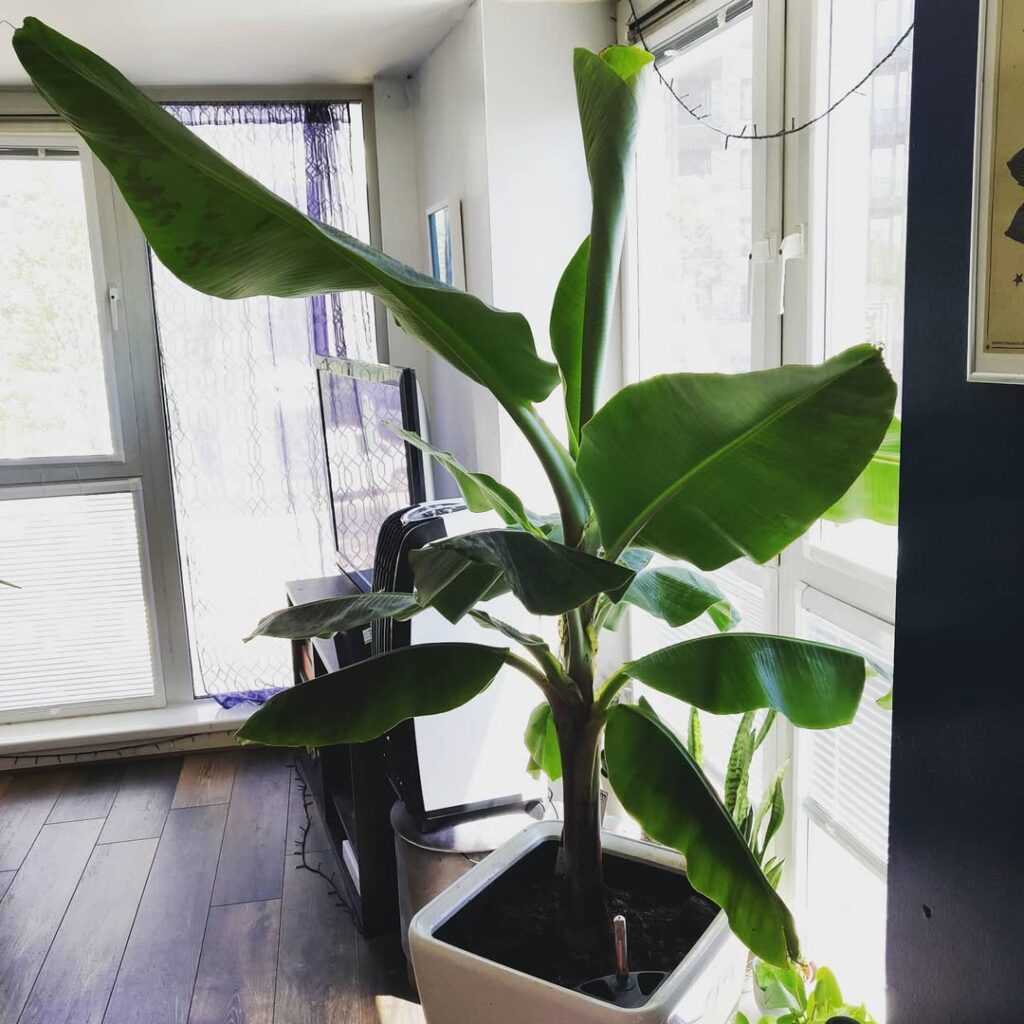
The Banana Plant (Musa) is a bold, tropical addition to indoor spaces, featuring large, paddle-shaped leaves that create an instant jungle-like feel. While most varieties don’t bear fruit indoors, their lush foliage and fast growth make them a favorite among plant enthusiasts.
- Light: Bright, indirect light; tolerates some direct sun but avoid harsh midday exposure
- Water: Keep soil consistently moist; allow top inch to dry out between waterings
- Soil: Well-draining, organic-rich potting mix
- Humidity: High humidity (60% or more); regular misting or a humidifier helps maintain optimal conditions
- Temperature: 70-85°F (21-29°C); sensitive to cold drafts
- Fertilizer: Feed biweekly with a balanced fertilizer during active growing months
- pH: 5.5-7.0
